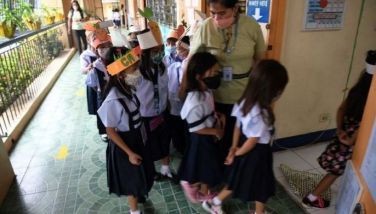Asteroid named after Filipino astronomer
June 2, 2005 | 12:00am
 CAMBRIDGE, Massachusetts — An asteroid has recently been named after a 75-year-old Filipino Jesuit astronomer and former director of the Manila Observatory, Fr. Victor L. Badillo.
CAMBRIDGE, Massachusetts — An asteroid has recently been named after a 75-year-old Filipino Jesuit astronomer and former director of the Manila Observatory, Fr. Victor L. Badillo.
According to the International Astronomical Union (IAU), minor planet No. 4866 measuring some 13 to 30 kilometers across is now officially known as "Badillo," in honor of the Filipino priest who popularized astronomy in the Philippines.
The IAU, through its 16-member Committee on Small Body Nomenclature, is the sole scientific organization with the authority and responsibility of christening small solar-system bodies such as asteroids and comets.
In the case of minor planets, for centuries they have been traditionally named after mythological figures and geographical places as well as renowned scientists, poets, composers, artists, novelists and other prominent personalities.
The official IAU citation for asteroid 4866 Badillo, published in Minor Planet Center (MPC) Circular No. 54173 on May 23, reads: "Victor L. Badillo (born 1930) has popularized astronomy in the Philippines for more than three decades, inspiring countless Filipino astronomers. Ordained in 1965, he directed the Jesuit-run Manila Observatory in Quezon City and served as president of the Philippine Astronomical Society from 1972 to 1990."
According to the MPC circular, the asteroid was discovered on Nov. 10, 1988 from Chiyoda, Japan, and was given the preliminary designation 1988 VB3. It revolves around the sun (between Mars and Jupiter) at an average distance of 450 million kilometers and takes about five years to complete one orbit.
Asteroid 4866 Badillo is currently about 596 kilometers from Earth, shining very dimly at magnitude 18 in the constellation Gemini.
"I am delighted and thrilled to have received this great honor," said Father Badillo, a physicist by training who obtained his Ph.D. from Saint Louis University in Missouri in 1963.
Father Badillo remains an amateur astronomer at heart, mentoring generations of Filipino stargazers through the years, including these writers.
This is the third time that Filipinos have been given this accolade. In 1995 the IAU named asteroid 6282 Edwelda in our honor. Edwelda, a combination of our first names, was in recognition of our accomplishments in the field of astronomy, including the book we wrote on Halley’s comet that the National Research Council of the Philippines published in 1985.
It was however American astronomer Carolyn Shoemaker who discovered asteroid 6282 in 1980 from Palomar Observatory near San Diego, California.
The second time was when a high school teacher and three students were cited for winning the 2002 Intel International Science and Engineering Fair in Louisville, Kentucky.
Josette Biyo and her students Allan Noriel Estrella, Jeric Valles Macalintal and Prem Vilas Fortran Rara were each honored with their own asteroid — 13241 Biyo, 11697 Estrella, 12088 Macalintal, and 12522 Rara, respectively.
These minor planets were discovered in 1998 by LINEAR, a robotic telescope in Socorro, New Mexico, operated by the Massachusetts Institute of Technology Lincoln Laboratory.
Asteroids are solid chunks of metal-rich rocks left over from the birth of our solar system some 4.5 billion years ago. They range from pebbles and boulders to the size of small islands of 600 to 1,000 kms.
(Edwin Aguirre and Imelda Joson have been working at Sky & Telescope magazine for more than 10 years. Edwin is an associate editor while Imelda is photo editor. — Editors)
BrandSpace Articles
<
>
- Latest
Latest
Latest
December 14, 2024 - 5:58pm
By Jing Castañeda | December 14, 2024 - 5:58pm
December 14, 2024 - 11:22am
By Karry Sison | December 14, 2024 - 11:22am
December 9, 2024 - 2:53pm
By Rupert Paul Manhit | December 9, 2024 - 2:53pm
November 30, 2024 - 5:19pm
By Joanna Perfecto | November 30, 2024 - 5:19pm
November 23, 2024 - 6:23pm
By Rupert Paul Manhit | November 23, 2024 - 6:23pm
November 23, 2024 - 1:52pm
By Edilberto de Jesus | November 23, 2024 - 1:52pm
Recommended





























